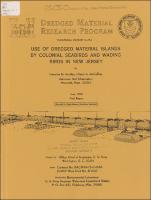Please use this identifier to cite or link to this item:
https://hdl.handle.net/11681/47643| Title: | Use of dredged material islands by colonial seabirds and wading birds in New Jersey |
| Authors: | Buckley, Francine G. McCaffrey, Cheryl A. |
| Keywords: | Water birds Shore birds New Jersey Islands Dredging Dredging spoil Dredged material Dredged Material Research Program (U.S.) |
| Publisher: | U.S. Army Engineer Waterways Experiment Station |
| Series/Report no.: | Technical Report (Dredged Material Research Program (U.S.)) ; no. Technical Report D-78-1 |
| Abstract: | The use of dredged material islands by colonial nesting seabirds and wading birds in New Jersey was examined in five major phases. The first located dredged material islands from Manasquan to Cape May Inlets, NJ; the second recorded the past history of all colonial nesting seabirds and wading birds in New Jersey; the third recorded the vegetation patterns and succession on 21 dredged material islands selected for intensive study; the fourth recorded the distribution in 1977 of colonial seabirds and wading birds in the study area and their utilization of dredged material islands; and the fifth documented those factors influencing the use and. selection of dredged material islands by birds in 1977. Plant communities were placed into 15 categories. The most important ones for birds on the dredged material study islands were bare, common reed, reed-shrub, shrub, shrub-forest, shrub-dense grassland, and dense grassland. More than 52,000 pairs of colonial seabirds and wading birds of 16 species nested in the study area. Their use of dredged material islands by percent of their total population ranged from zero (Forster’s terns) to 71 percent (herons). No statistically significant vegetation differences were found between the 11 bird (colony) and 10 vegetation (non-colony) study islands, leading to the conclusion that other factors, notably microtopography, past history of colony success, and freedom from disturbance by quadruped predators and humans, may be the most important in determining island use by birds, given certain minimal habitat requirements. Nineteen management recommendations for dredged material islands are stated, including annual wildlife surveys, careful monitoring of contractor performance, attention to record keeping, preservation of alternative colony sites, rotational use and management of dredged material islands, proportional habitat creation and management, and protection of all islands with bird colonies. |
| Description: | Technical Report |
| Gov't Doc #: | Technical Report D-78-1 |
| Rights: | Approved for Public Release; Distribution is Unlimited |
| URI: | https://hdl.handle.net/11681/47643 |
| Appears in Collections: | Technical Report |
Files in This Item:
| File | Description | Size | Format | |
|---|---|---|---|---|
| Technical Report D-78-1.pdf | 116.76 MB | Adobe PDF |  View/Open |